Grace Mappes, Karolina Hird, Riley Bailey, Christina Harward, and Mason Clark
Ukrainian forces made confirmed advances in the Donetsk-Zaporizhia Oblast border area and in western Zaporizhia Oblast and made claimed advances south of Bakhmut on September 9. Geolocated footage published on September 9 shows that Ukrainian forces advanced northwest of Novomayorske (18km southeast of Velyka Novosilka) along the Donetsk-Zaporizhia Oblast border, where Russian sources claim fighting has intensified in recent days.[1] Additional geolocated footage published on September 9 shows that Ukrainian forces also advanced northeast and east of Novoprokopivka (13km south of Orikhiv) and west of Verbove (20km southeast of Orikhiv) in western Zaporizhia Oblast.[2] The Ukrainian General Staff reported that Ukrainian forces achieved unspecified successes south of Robotyne (10km south of Orikhiv).[3] A Kremlin-affiliated Russian milblogger claimed that Ukrainian forces forced Russian forces to withdraw from Andriivka (9km southwest of Bakhmut), and another prominent milblogger claimed that Andriivka is now a contested “gray zone.”[4] Ukrainian officials reported that Ukrainian forces also achieved unspecified success south of Klishchiivka.[5]
Ukrainian Main Military Intelligence Directorate (GUR) Spokesperson Vadym Skibitskyi reemphasized Ukraine’s right to target critical Russian strategic and military objects in rear areas. Skibitskyi stated on September 8 that Ukraine identifies and strikes the most critical Russian objects in Russian rear areas using drones, missiles, and agents on Russian territory.[6] Skibitskyi emphasized that Ukrainian forces target military facilities and objects of the military-industrial complex that help with missile production and logistics support. Skibitskyi stated that Ukraine purposefully targets these objects to degrade Russian offensive potential and achieve a “domino effect” where destroying one object forces other dependent enterprises to stop production.
Russia’s war in Ukraine is increasingly constraining Russian local and regional politics, with even the minimal pre-war competition suppressed and regional governments increasingly focused on their ability to generate resources for the war. Radio Free Europe/Radio Liberty (RFE/RL)’s Tatar-Bashkir service Idel Realii posted an interview on September 8 with Russian political scientist Dmitry Loboyko regarding “the peculiarities of election campaigns during the war.”[7] Loboyko stated that this election season is one of the most “uncompetitive” in Russian history and that it particularly lacks opposition alternatives, especially as people are increasingly voting with the mindset that the war in Ukraine may last a year, five years, or even ten years.[8] Loboyko also noted that Russian federal subjects (regions) are competing for resources on the basis of how many military personnel each region was able to mobilize for the war, with the insinuation that the federal government allocates more resources to regions that mobilized more personnel, thereby increasing inter-regional competition.[9] Loboyko’s insights suggest that the war in Ukraine, and its continued drain on Russian regions, has contributed to a more muted political atmosphere within Russia. ISW has previously observed that Russian officials, particularly those affiliated with the leading United Russia party, appear concerned with the impacts the war will have on the electorate during local and regional elections, and the muted political atmosphere outlined by Loboyko aligns with these observations.[10] Various Russian insider sources additionally reported on September 9 that Russian President Vladimir Putin has publicly backed Nizhny Novgorod Governor Gleb Nitkin, Moscow Mayor Sergei Sobyanin, and Smolensk Governor Vasily Anokhin in the regional elections.[11] The insider sources suggested that the Kremlin is invested in publicly backing the infrastructure and connectivity projects that these regional leaders espouse.[12] As the war continues, Russian officials will likely continue to have to balance the suppression of domestic political opposition with the need to posture the government as being actively involved in ameliorating domestic matters.
The Kremlin continues to refuse to rejoin the Black Sea Grain Initiative in an attempt to extract maximum concessions from the West and may believe that apparent support or acceptance for its demands from some international actors offers it more leverage in renegotiating the deal. Kremlin Spokesperson Dmitry Peskov reiterated on September 9 that Russia will not resume its participation in the grain deal until all its demands are met.[13] Peskov specifically highlighted the Kremlin’s demand for the reconnection of the Russian Agricultural Bank to the Society for Worldwide Interbank Financial Telecommunications (SWIFT) banking system and suggested that the reconnection of one of the bank’s subsidiaries is insufficient.[14] UN Secretary General Antonio Guterres recently sent a letter to Russian Foreign Minister Sergey Lavrov offering extensive concessions for Russia’s return to the deal, which included SWIFT reconnection for a Russian Agricultural Bank subsidiary in Luxembourg.[15] Turkish President Recep Tayyip Erdogan similarly supported offering Russia extensive concessions during the G20 summit in New Delhi, where he reportedly called on G20 leaders to resume insurance for Russian grain and fertilizer cargos and to reconnect Russian banks to SWIFT.[16] The Kremlin may believe that Erdogan’s and Guterres’ support for offering concessions places further pressure on the West to acquiesce to Russian demands for rejoining the grain deal, and Russian officials will likely continue to reject offers that meet many of these demands in the hope of extracting a maximalist set of concessions.[17] The Kremlin may alternatively have no intention of returning to the grain deal, however, and may instead aim to increase the market share and attractiveness of Russian grain by degrading Ukrainian grain export potential through continued strikes on grain and port infrastructure.[18]
The Telegraph reported on September 8 that the United Kingdom’s military aircraft are conducting patrols over the Black Sea to deter Russian forces from conducting attacks against civilian vessels carrying grain exports.[19] NATO previously announced on July 26 that it would increase surveillance and reconnaissance in the Black Sea region, including with maritime patrol aircraft and drones, given Russian threats against civilian ships and attacks on Ukrainian ports.[20]
The Group of 20 (G20) adopted a standard and boilerplate consensus declaration during the G20 summit on September 9 that called for a “durable peace” in Ukraine without explicitly condemning Russia’s invasion of Ukraine.[21] The G20 advocated for all states party to the G20 mandate to uphold the rules and principles of international law and called for initiatives that would lead to a “comprehensive, just, and durable peace in Ukraine.”[22]
Key Takeaways:
- Ukrainian forces made confirmed advances in the Donetsk-Zaporizhia Oblast border area and in western Zaporizhia Oblast and made claimed advances south of Bakhmut on September 9.
- Ukrainian Main Military Intelligence Directorate (GUR) Spokesperson Vadym Skibitskyi reemphasized Ukraine’s right to target critical Russian strategic and military objects in rear areas.
- Russia’s war in Ukraine is increasingly constraining Russian local and regional politics, with even the minimal pre-war competition suppressed and regional governments increasingly focused on their ability to generate resources for the war.
- The Kremlin continues to refuse to rejoin the Black Sea Grain Initiative in an attempt to extract maximum concessions from the West and may believe that apparent support or acceptance for its demands from some international actors offers it more leverage in renegotiating the deal.
- Russian forces conducted offensive operations along the Kupyansk-Svatove-Kreminna line, near Bakhmut, along the Avdiivka-Donetsk City line, in the western Donetsk-eastern Zaporizhia Oblast border area, and in western Zaporizhia and advanced in some areas on September 9.
- Russian occupation authorities continue efforts to manufacture a guise of legitimacy and legality around ongoing local elections in occupied regions of Ukraine.
We do not report in detail on Russian war crimes because these activities are well-covered in Western media and do not directly affect the military operations we are assessing and forecasting. We will continue to evaluate and report on the effects of these criminal activities on the Ukrainian military and the Ukrainian population and specifically on combat in Ukrainian urban areas. We utterly condemn these Russian violations of the laws of armed conflict, Geneva Conventions, and humanity even though we do not describe them in these reports.
- Russian Main Effort – Eastern Ukraine (comprised of two subordinate main efforts)
- Russian Subordinate Main Effort #1 – Capture the remainder of Luhansk Oblast and push westward into eastern Kharkiv Oblast and encircle northern Donetsk Oblast
- Russian Subordinate Main Effort #2 – Capture the entirety of Donetsk Oblast
- Russian Supporting Effort – Southern Axis
- Russian Mobilization and Force Generation Efforts
- Activities in Russian-occupied areas
Russian Main Effort – Eastern Ukraine
Russian Subordinate Main Effort #1 – Luhansk Oblast (Russian objective: Capture the remainder of Luhansk Oblast and push westward into eastern Kharkiv Oblast and northern Donetsk Oblast)
Russian forces continued offensive operations along the Kupyansk-Svatove-Kreminna line and reportedly advanced on September 9. Russian sources claimed that Russian forces advanced near Synkivka (9km northeast of Kupyansk), Petropavlivka (7km east of Kupyansk), and Novoyehorivka (16km southwest of Svatove) on September 8 and 9.[23] Russian Western Grouping of Forces Spokesperson Sergey Zybinsky claimed on September 9 that Russian forces captured five Ukrainian positions south of Serhiivka (12km southwest of Svatove).[24] The Ukrainian General Staff reported that Ukrainian forces repelled Russian ground attacks near Synkivka (8km northeast of Kupyansk), Novoyehorivka, and Berestove (30km south of Kreminna), and southeast of Dibrova (7km southwest of Kreminna).[25] Ukrainian Eastern Group of Forces Spokesperson Ilya Yevlash stated that Russian forces in the Kupyansk direction are completing the formation of combat-ready assault units constituted piecemeal from defeated units, but noted that these new units are entirely composed of rear-area elements without combat experience.[26]
Russian officials claimed that Ukrainian forces conducted limited unsuccessful attacks on the Kupyansk-Svatove-Kreminna line on September 9. Zybinsky claimed that Russian forces repelled three Ukrainian attacks in the direction of Kovalivka (12km southwest of Svatove).[27] Russian Central Grouping of Forces Spokesperson Alexander Savchuk claimed that Russian forces repelled six Ukrainian attacks near Torske (14km west of Kreminna) and the Serebryanske forest area (11km south of Kreminna).[28]
Russian Subordinate Main Effort #2 – Donetsk Oblast (Russian objective: Capture the entirety of Donetsk Oblast, the claimed territory of Russia’s proxies in Donbas)
Ukrainian forces continued offensive operations around Bakhmut on September 9 and reportedly advanced. The Ukrainian General Staff and Ukrainian Eastern Group of Forces Spokesperson Ilya Yevlash stated that Ukrainian forces achieved unspecified success south of Klishchiivka (7km southwest of Bakhmut).[29] A prominent Russian milblogger claimed that Ukrainian forces completely pushed Russian forces out of Andriivka (10km southwest of Bakhmut), although ISW has yet to observe visual confirmation that Ukrainian forces have liberated the settlement.[30] The milblogger claimed that the Russian line of control in the area now passes along the railway line east of Andriivka and Klishchiivka.[31] Other Russian sources acknowledged that Ukrainian forces control the majority of Klishchiivka, although one Russian milblogger asserted that Klishchiivka and Andriivka are contested “gray zones.”[32]
Russian forces counterattacked in the Bakhmut area on September 9 but did not make any confirmed gains. The Ukrainian General Staff reported that Russian forces unsuccessfully attempted to break through Ukrainian positions near Orikhovo-Vasylivka (11km northwest of Bakhmut) and regain lost positions near Klishchiivka, Andriivka, and Kurdyumivka (13km southwest of Bakhmut).[33] A Russian milblogger claimed that Russian forces counterattacked near Andriivka, tried to recapture heights near Klishchiivka, and attempted to push Ukrainian forces back from positions near Orikhovo-Vasylivka but did not specify an outcome.[34] Other Russian milbloggers claimed that Russian forces counterattacked from positions in the northeastern outskirts of Klishchiivka and made marginal unspecified gains near Orikhovo-Vasylivka.[35]
Russian forces continued limited offensive operations along the Avdiivka-Donetsk City line on September 9 but did not advance. The Ukrainian General Staff reported that Russian forces unsuccessfully attempted to dislodge Ukrainian forces from positions near Avdiivka and Marinka (27km southwest of Avdiivka) 10 times.[36] The Ukrainian General Staff reported that Russian forces also conducted assaults near Krasnohorivka (22km southwest of Avdiivka) and Novokalynove (12km northwest of Avdiivka).[37] A Russian milblogger claimed that Russian forces also attacked Ukrainian positions near Novomykhailivka (36km southwest of Avdiivka) and on the southern approaches to Avdiivka but did not specify an outcome.[38]
Russian Supporting Effort – Southern Axis (Russian objective: Maintain frontline positions and secure rear areas against Ukrainian strikes)
Ukrainian forces conducted offensive operations in the western Donetsk-eastern Zaporizhia Oblast border area and advanced on September 9. Geolocated footage published on September 9 indicates that Ukrainian forces advanced northwest of Novomayorske (18km southeast of Velyka Novosilka).[39] Some Russian milbloggers claimed that Ukrainian forces advanced near Novodonetske (12km southeast of Velyka Novosilka) and northeast of Novomayorske.[40] Other Russian sources claimed on September 8 and 9 that Ukrainian forces unsuccessfully attacked near Novomayorske and Novodonetske and that Russian forces repelled all Ukrainian attempts to cross the Shaytanka River immediately northeast of the settlements, however.[41][42]
Russian forces conducted offensive operations in the western Donetsk-eastern Zaporizhia Oblast border area on September 9 and reportedly advanced. Russian sources claimed on September 8 and 9 that Russian forces attacked near Pryyutne (16km southwest of Velyka Novosilka) and advanced up to three kilometers to the Hrusheva Gully, although ISW has not observed visual evidence of this claim.[43] A Russian milblogger claimed that Russian forces recaptured positions on the outskirts of Novodonetske and Novomayorske after Ukrainian forces gained a foothold in these positions on September 8.[44] Russian sources claimed that elements of the Russian 37th Motorized Rifle Brigade (36th Combined Arms Army, Eastern Military District), 40th Naval Infantry Brigade (Pacific Fleet), 4th Infantry Brigade, 5th Brigade (1st Donetsk People’s Republic [DNR] Army Corps) and the DNR “Kaskad” Operational Tactical Combat Formation are operating on the Novodonestke-Novomayorske line and that elements of the Russian 127th Motorized Rifle Division (5th Combined Arms Army, Eastern Military District) are operating near Pryyutne.[45]
Ukrainian forces conducted offensive operations in western Zaporizhia Oblast and advanced on September 9. Geolocated footage published on September 9 indicates that Ukrainian forces advanced northeast and east of Novoprokopivka (13km south of Orikhiv), west of Verbove (20km southeast of Orikhiv), and south of Robotyne (10km south of Orikhiv).[46] The Ukrainian General Staff reported that Ukrainian forces achieved unspecified success south of Robotyne.[47] Russian milbloggers claimed that Ukrainian forces unsuccessfully attacked south of Robotyne, east and northeast of Novoprokopivka, and near Verbove.[48]
Russian forces conducted offensive operations in western Zaporizhia Oblast but did not advance on September 9. The Ukrainian General Staff reported that Russian forces unsuccessfully attacked near Robotyne.[49] The Ukrainian General Staff and the UK MoD stated that Russian forces have deployed units, including elements of relatively elite Airborne (VDV) formations, to western Zaporizhia Oblast to replace degraded units operating near Robotyne, and a Ukrainian source stated that two regiments of the Russian 76th Guards Air Assault (VDV) Division have arrived in the Tokmak area.[50] The commitment of some of the Russian military’s most capable formations for limited counterattacks in this critical sector of the front will likely attrit these formations further.
A Russian milblogger claimed that small Ukrainian groups landed on areas in the Dnipro River on September 8. A Russian milblogger claimed that a 12-person Ukrainian force landed on the eastern part of Oleshkivskyi Island (southeast of Antonivka) and a 10-person Ukrainian force landed near the Antonivsky rail bridge to Prydniprovske on the night of September 8.[51]
Russian Mobilization and Force Generation Efforts (Russian objective: Expand combat power without conducting general mobilization)
Russian military officials continue to publicly emphasize that Russia will not conduct another mobilization wave. Russian State Duma Defense Committee Head Andrey Kartapolov claimed on September 9 that Russia does not need to conduct another mobilization wave to rotate personnel in Ukraine as Russia has recruited enough contract personnel to complete rotations. Kartapolov claimed that Russia has recruited over 200,000 contract personnel in 2023, which Kartapolov claimed is almost enough to conduct a one-to-one rotation with the 300,000 personnel Kartapolov claimed Russia mobilized during partial mobilization in fall 2022.[52]
Russia continues efforts to develop and produce UAVs outside of the Alabuga Special Economic Zone (SEZ) in the Republic of Tatarstan. The Republic of Sakha (Yakutia) announced the creation of a regional UAV research and production center in the republic.[53] Yakutia Head Aisen Nikolaev, Kremlin Spokesperson and National Technology Initiative Platform General Director Dmitry Peskov, and Yakutia Technopark Director signed a memorandum establishing technological cooperation to develop Yakutia’s technological industry over the next three years.[54] The “Vostok” Design Bureau based in Barnaul, Altai Krai announced on September 7 that it is testing the “Scalpel” multi-purpose UAV, which Russian forces plan to use as a loitering munition.[55] The “Vostok” Design Bureau stated that it plans to begin mass-producing Scalpels in October 2023 for Russian forces to use in Ukraine.[56] Alexander Khodakovsky, commander of the Vostok Battalion operating along the Donetsk-Zaporizhia Oblast border, claimed that some Russian forces ran out of Lancet loitering munitions soon after the start of the Ukrainian counteroffensive and that more of these drones would help conserve Russian manpower and target Ukrainian military assets.[57]
Reuters reported that Russia may be able to increase its artillery ammunition production in the coming years beyond prior Western expectations but in amounts still insufficient for the war in Ukraine. Reuters cited an anonymous Western official as reporting that Russia may be able to increase its artillery ammunition production to up to two million shells per year in the “next couple years.”[58] The official reportedly estimated that Russian forces fired between 10 and 11 million shells in 2022, and characterized the production and supply disparity as not “a very strong position.”[59] Russian milbloggers frequently complain of artillery and ammunition shortages and ineffective artillery targeting in frontline areas, including critical areas during the Ukrainian counteroffensive.[60]
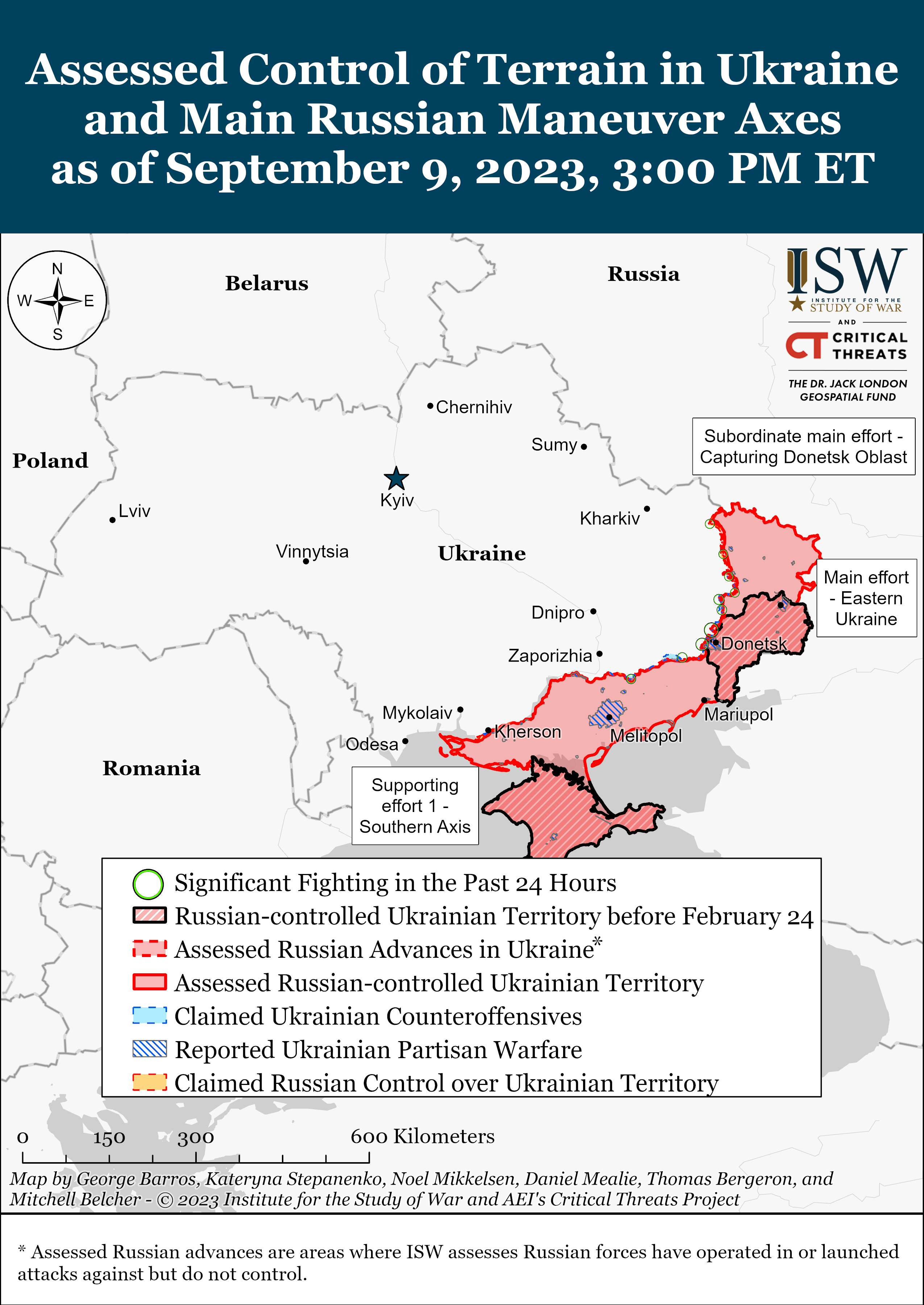
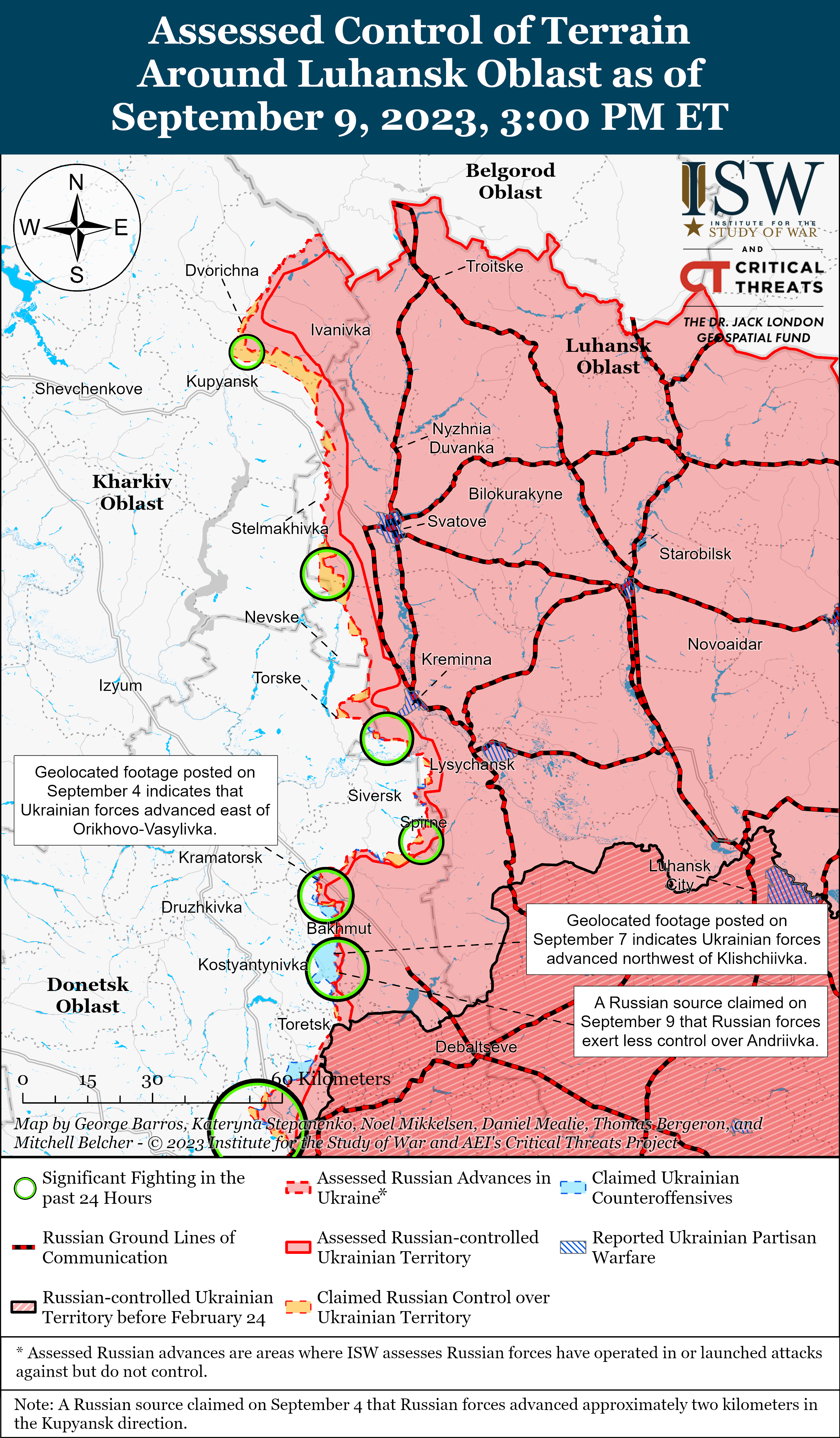
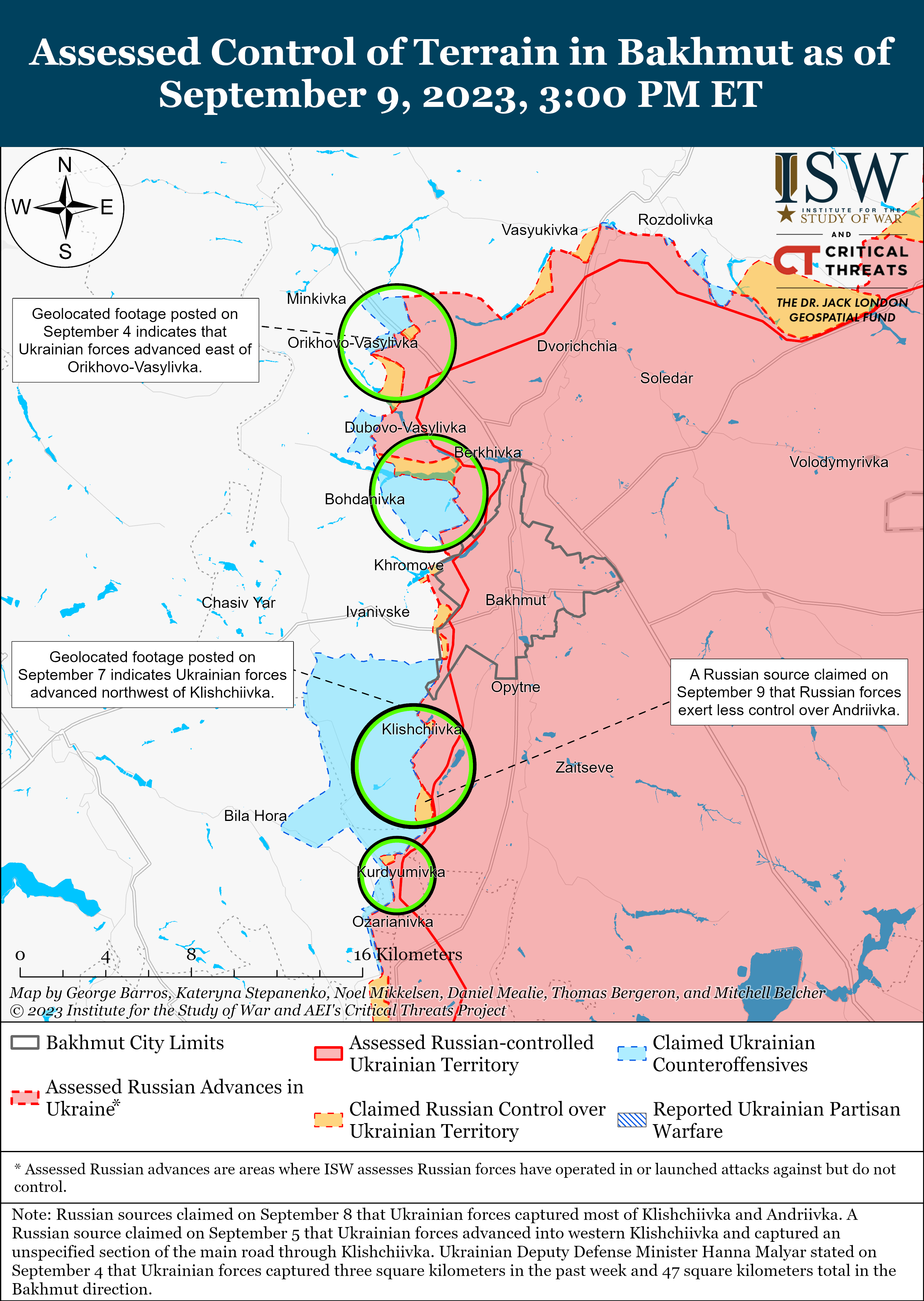
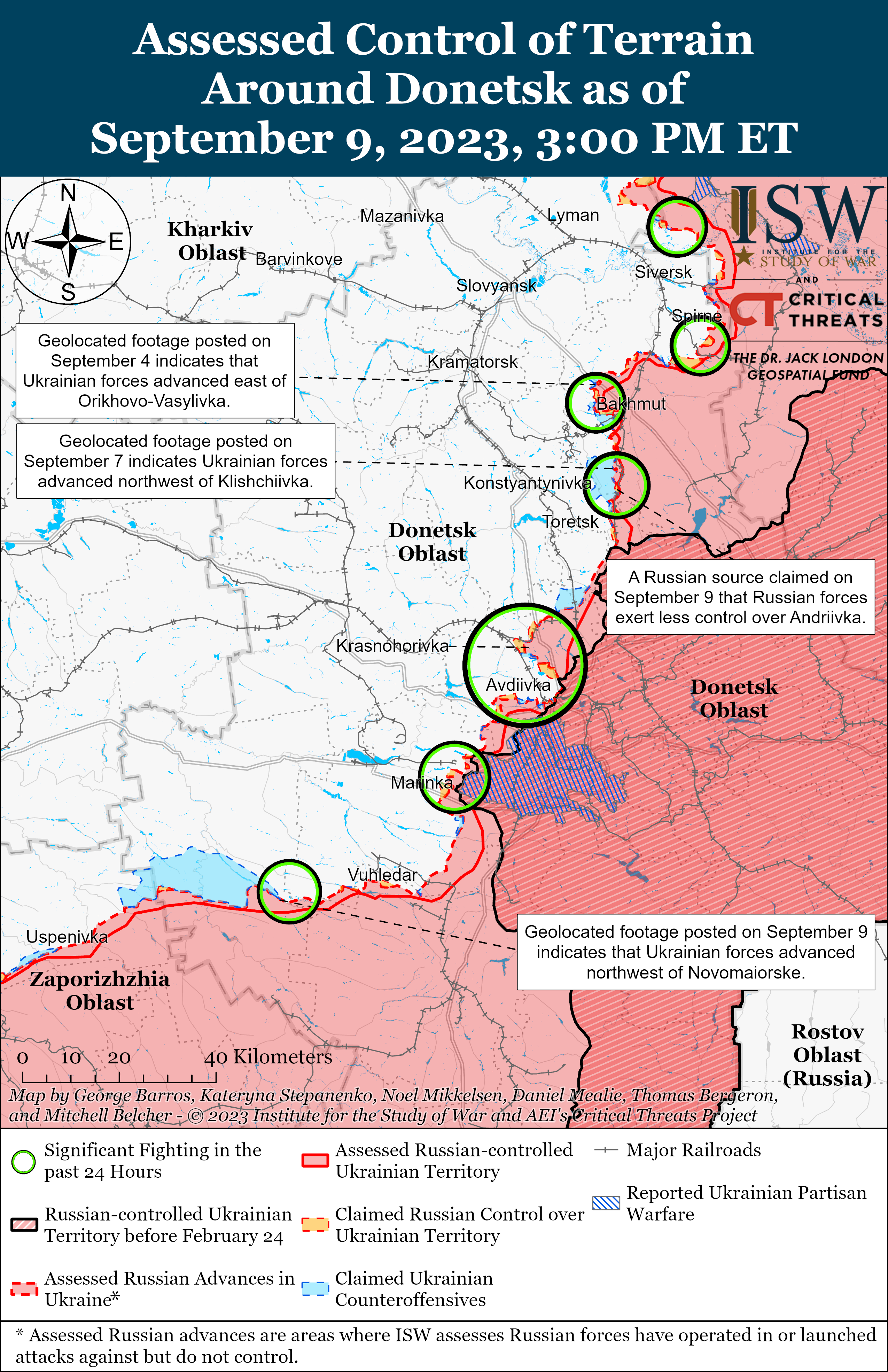
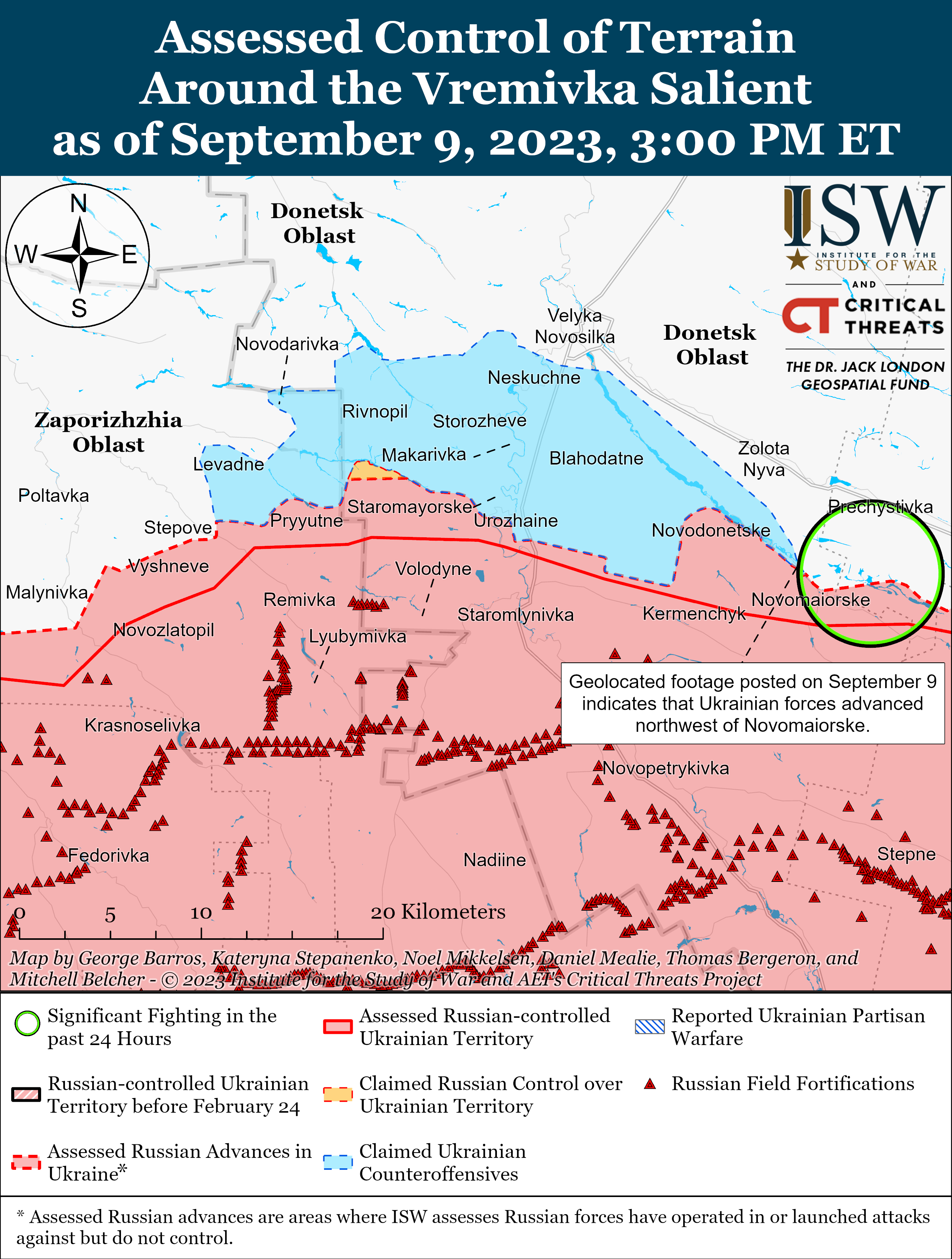
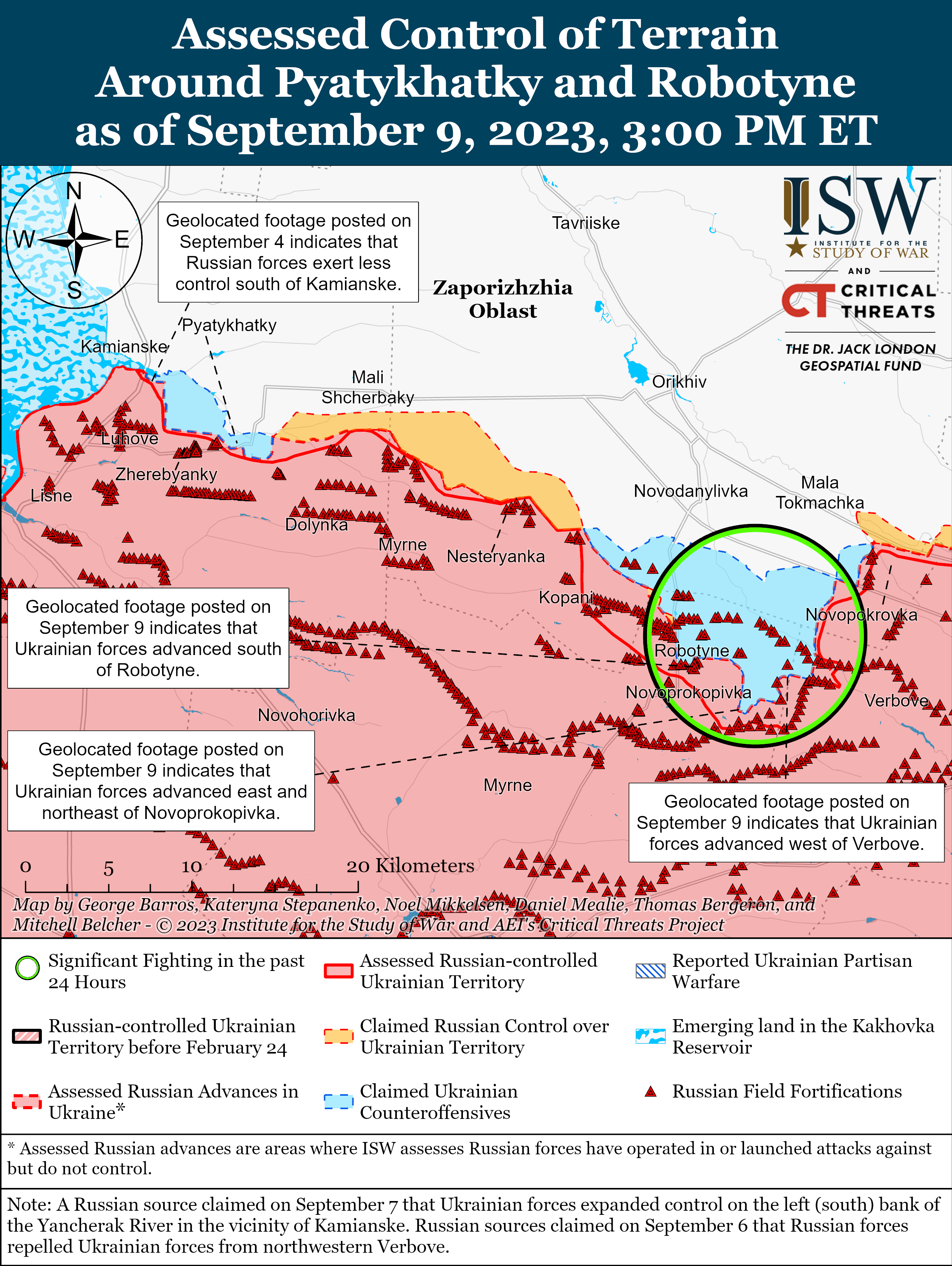
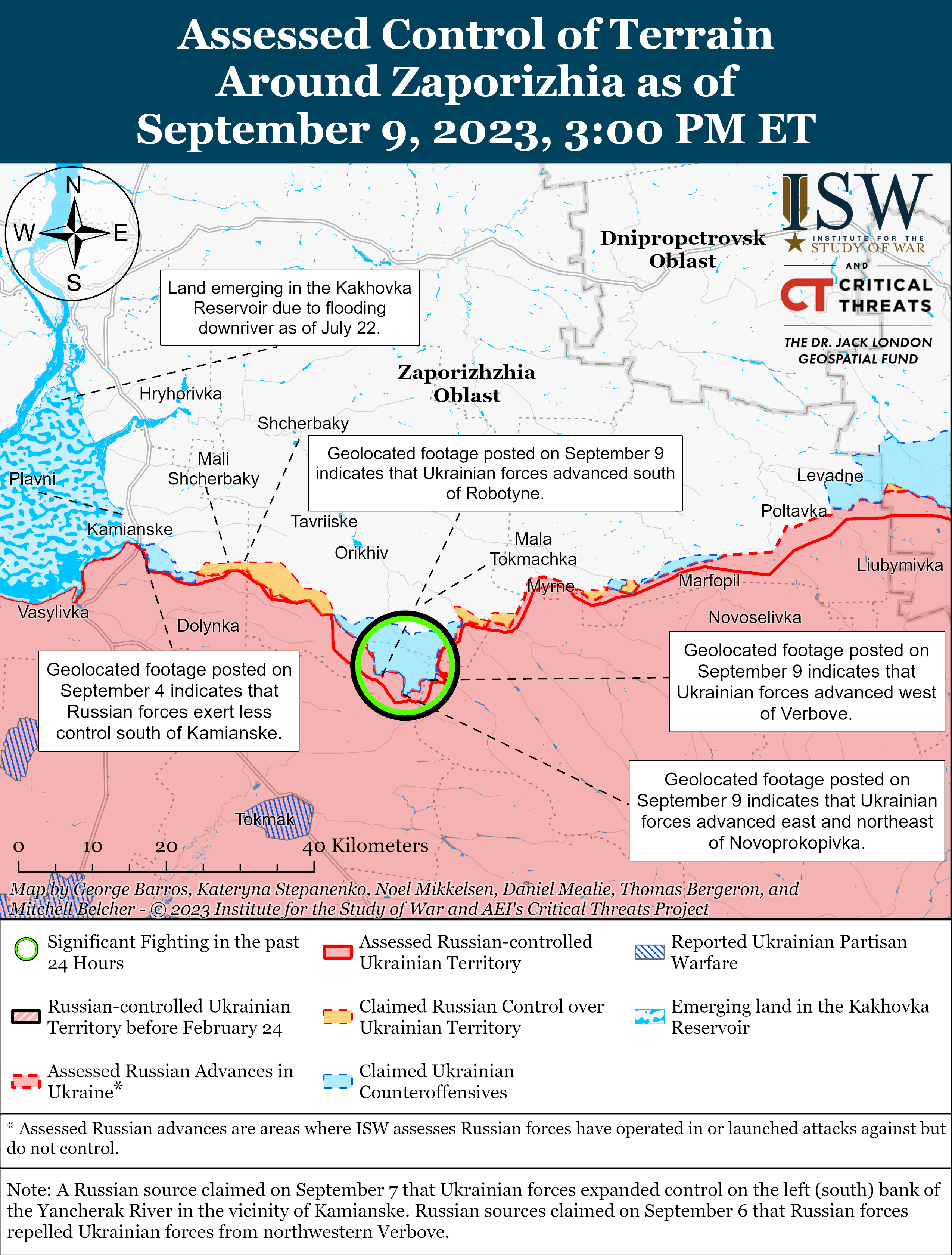
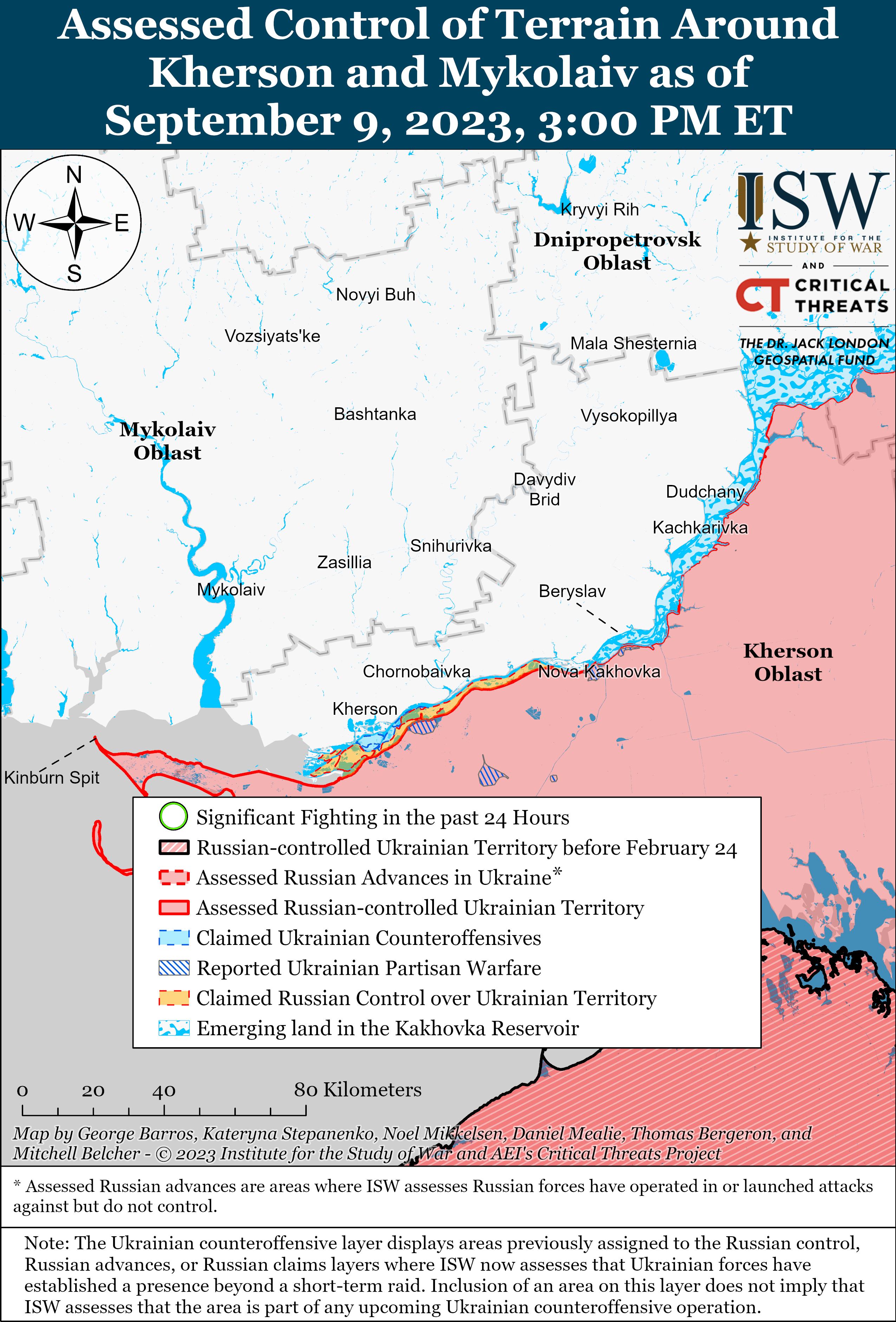
No comments:
Post a Comment